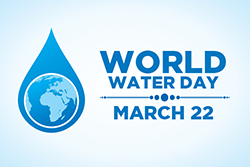Media
Contact
Communications Specialist
Faculty of Engineering
Spencer Engineering Building
Room 2072
Western University
Tel: 519-661-2111 ext. 87015
Email: engineeringcomms@uwo.ca
Western Engineering observes World Water Day
 Western Engineering News | March 22, 2018
Western Engineering News | March 22, 2018
March 22 is recognized internationally as World Water Day. Most Canadians likely aren’t even thinking about water in their day-to-day lives. However, those who work in this field are thinking about water, in all forms, 365 days a year.
“Climate change is resulting in extreme weather and putting more pressure on all of us, but do we see the link between climate change and changes to the water cycle? Water is the most valuable asset we have,” says Slobodan Simonovic, Professor in Civil Engineering and Director of Engineering Works at the Institute for Catastrophic Loss Reduction.
This year’s theme for World Water Day is Nature Based Solutions (NBS). Restoring forests, grasslands and natural wetlands, reconnecting rivers to floodplains, and creating buffers of vegetation along water courses are all examples of NBS that help the management of water availability and quality. Most NBS, including in urban landscapes, essentially involve the management of vegetation, soils and wetlands, including rivers and lakes.
“NBS are not a panacea to the critical water-related challenges we face as the global population grows, but they can provide innovative and cost-effective options for supplementing insufficient or ageing water infrastructure,” says Simonovic.
In order to help us gain a better understanding of the resource on which we all depend, Simonovic and his team of researchers provided some facts about water and its worldwide usage.
- 1 billion people still lack access to safely managed drinking water services.
- By 2050, the world’s population will have grown by an estimated 2 billion people and global water demand could be up to 30% higher than today.
- Agriculture currently accounts for 70% of global water withdrawals, mostly for irrigation – a figure which rises in areas of high water stress and population density. Industry takes 20% of the total, dominated by energy and manufacturing. The remaining 10% goes to domestic use – the proportion used for drinking water is much less than 1%.
- Today, around 1.9 billion people live in potentially severely water-scarce areas. By 2050, this could increase to around 3 billion people.
- An estimated 1.8 billion people use an unimproved source of drinking water with no protection against contamination from human feces.
- Globally, over 80% of the wastewater generated by society flows back into the environment without being treated or reused.
- The number of people at risk from floods is projected to rise from 1.2 billion today to around 1.6 billion in 2050 – nearly 20% of the world’s population.
- Today, around 1.8 billion people are affected by land degradation and desertification. At least 65% of forested land is in a degraded state.
- An estimated 64-71% of natural wetlands have been lost since 1900 as a result of human activity.
- Soil erosion from croplands carries away 25 to 40 billion tons of topsoil every year, significantly reducing crop yields and the soil’s ability to regulate water, carbon and nutrients. The runoff, containing large amounts of nitrogen and phosphorous, is also a major contributor to water pollution.
For more information on World Water Day, visit worldwaterday.org.
For more information on water research being done at Western Engineering, visit eng.uwo.ca/waterengineering.

